日本军国主义崛起 英文
- 格式:ppt
- 大小:332.50 KB
- 文档页数:11
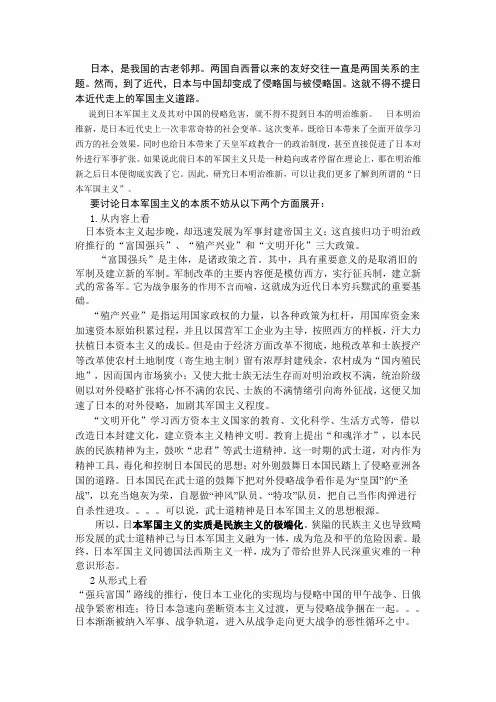
日本,是我国的古老邻邦。
两国自西晋以来的友好交往一直是两国关系的主题。
然而,到了近代,日本与中国却变成了侵略国与被侵略国。
这就不得不提日本近代走上的军国主义道路。
说到日本军国主义及其对中国的侵略危害,就不得不提到日本的明治维新。
日本明治维新,是日本近代史上一次非常奇特的社会变革。
这次变革,既给日本带来了全面开放学习西方的社会效果,同时也给日本带来了天皇军政教合一的政治制度,甚至直接促进了日本对外进行军事扩张。
如果说此前日本的军国主义只是一种趋向或者停留在理论上,那在明治维新之后日本便彻底实践了它。
因此,研究日本明治维新,可以让我们更多了解到所谓的“日本军国主义”。
要讨论日本军国主义的本质不妨从以下两个方面展开:1.从内容上看日本资本主义起步晚,却迅速发展为军事封建帝国主义;这直接归功于明治政府推行的“富国强兵”、“殖产兴业”和“文明开化”三大政策。
“富国强兵”是主体,是诸政策之首。
其中,具有重要意义的是取消旧的军制及建立新的军制。
军制改革的主要内容便是模仿西方,实行征兵制,建立新式的常备军。
它为战争服务的作用不言而喻,这就成为近代日本穷兵黩武的重要基础。
“殖产兴业”是指运用国家政权的力量,以各种政策为杠杆,用国库资金来加速资本原始积累过程,并且以国营军工企业为主导,按照西方的样板,汗大力扶植日本资本主义的成长。
但是由于经济方面改革不彻底,地税改革和士族授产等改革使农村土地制度(寄生地主制)留有浓厚封建残余,农村成为“国内殖民地”,因而国内市场狭小;又使大批士族无法生存而对明治政权不满,统治阶级则以对外侵略扩张将心怀不满的农民、士族的不满情绪引向海外征战,这便又加速了日本的对外侵略,加剧其军国主义程度。
“文明开化”学习西方资本主义国家的教育、文化科学、生活方式等,借以改造日本封建文化,建立资本主义精神文明。
教育上提出“和魂洋才”,以本民族的民族精神为主,鼓吹“忠君”等武士道精神。
这一时期的武士道,对内作为精神工具,毒化和控制日本国民的思想;对外则鼓舞日本国民踏上了侵略亚洲各国的道路。
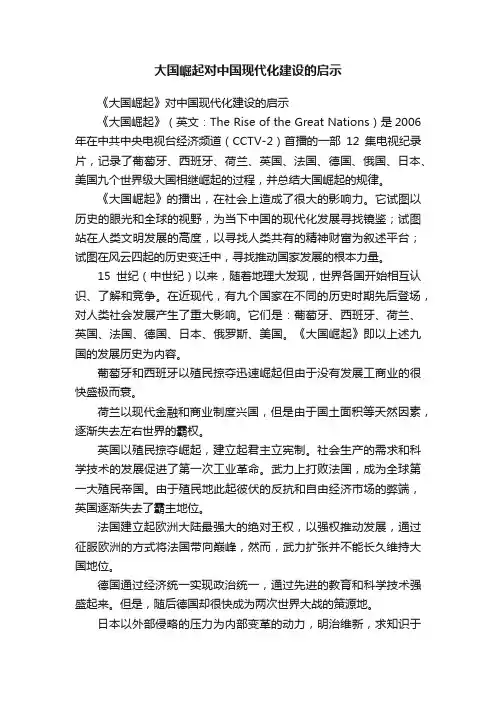
大国崛起对中国现代化建设的启示《大国崛起》对中国现代化建设的启示《大国崛起》(英文:The Rise of the Great Nations)是2006年在中共中央电视台经济频道(CCTV-2)首播的一部12集电视纪录片,记录了葡萄牙、西班牙、荷兰、英国、法国、德国、俄国、日本、美国九个世界级大国相继崛起的过程,并总结大国崛起的规律。
《大国崛起》的播出,在社会上造成了很大的影响力。
它试图以历史的眼光和全球的视野,为当下中国的现代化发展寻找镜鉴;试图站在人类文明发展的高度,以寻找人类共有的精神财富为叙述平台;试图在风云四起的历史变迁中,寻找推动国家发展的根本力量。
15世纪(中世纪)以来,随着地理大发现,世界各国开始相互认识、了解和竞争。
在近现代,有九个国家在不同的历史时期先后登场,对人类社会发展产生了重大影响。
它们是:葡萄牙、西班牙、荷兰、英国、法国、德国、日本、俄罗斯、美国。
《大国崛起》即以上述九国的发展历史为内容。
葡萄牙和西班牙以殖民掠夺迅速崛起但由于没有发展工商业的很快盛极而衰。
荷兰以现代金融和商业制度兴国,但是由于国土面积等天然因素,逐渐失去左右世界的霸权。
英国以殖民掠夺崛起,建立起君主立宪制。
社会生产的需求和科学技术的发展促进了第一次工业革命。
武力上打败法国,成为全球第一大殖民帝国。
由于殖民地此起彼伏的反抗和自由经济市场的弊端,英国逐渐失去了霸主地位。
法国建立起欧洲大陆最强大的绝对王权,以强权推动发展,通过征服欧洲的方式将法国带向巅峰,然而,武力扩张并不能长久维持大国地位。
德国通过经济统一实现政治统一,通过先进的教育和科学技术强盛起来。
但是,随后德国却很快成为两次世界大战的策源地。
日本以外部侵略的压力为内部变革的动力,明治维新,求知识于世界,开始了国家工业化,并从被侵略者迅速转变为侵略者,日本走上武力扩张之路,原子弹爆炸的蘑菇云结束了日本军国主义的迷梦。
俄国沙皇以强权推动改革,向外发动战争,领土得到扩张。

全面侵华战争英语The Sino-Japanese War: A Tragic Clash of Nationalism and ImperialismThe early 20th century was a tumultuous period in East Asia, marked by the rise of aggressive nationalism and competing imperial ambitions. At the heart of this turbulent era was the Sino-Japanese War, a conflict that would have far-reaching consequences for the region and the world. This war, which lasted from 1937 to 1945, was a complex and multifaceted event that cannot be reduced to a simple narrative of aggression and resistance.The roots of the Sino-Japanese War can be traced back to the late 19th century, when Japan emerged as a formidable military power following the Meiji Restoration. Driven by a desire to emulate the success of Western colonial powers, Japan sought to expand its sphere of influence in Asia. This led to a series of conflicts with China, culminating in the First Sino-Japanese War of 1894-1895, in which Japan emerged victorious and gained control of Taiwan and the Liaodong Peninsula.The aftermath of the First Sino-Japanese War sowed the seeds of thelater conflict. China's humiliating defeat at the hands of a smaller and less-developed nation fueled a growing sense of nationalism and a determination to regain its rightful place in the regional order. Meanwhile, Japan's success emboldened its military leaders, who increasingly saw China as a threat to their ambitions of regional hegemony.The immediate trigger for the Sino-Japanese War was the Marco Polo Bridge Incident of 1937, in which a skirmish between Chinese and Japanese troops near Beijing escalated into a full-scale military confrontation. Japan, seizing the opportunity, launched a massive invasion of China, quickly capturing major cities and establishing a puppet government in Nanjing.The Japanese military's conduct during the war was marked by extreme brutality and disregard for civilian lives. The Nanjing Massacre, in which Japanese troops systematically killed an estimated 300,000 Chinese civilians, stands as one of the most horrific atrocities of the 20th century. The widespread use of chemical weapons, the forced conscription of laborers, and the systematic exploitation of the occupied territories all contributed to the immense suffering of the Chinese people.China's resistance to the Japanese invasion was no less remarkable. Led by the Nationalist government of Chiang Kai-shek and theCommunist forces of Mao Zedong, the Chinese people fought with a tenacity and courage that surprised their Japanese adversaries. The long and arduous guerrilla campaign, combined with the logistical challenges of the vast Chinese landscape, ultimately proved too much for the Japanese military to overcome.The Sino-Japanese War also had significant international implications. The conflict drew the attention of the global community, with the United States and the Soviet Union providing varying degrees of support to the Chinese forces. The war also contributed to the growing tensions between the Axis and Allied powers, ultimately leading to Japan's involvement in the broader conflict of World War II.The legacy of the Sino-Japanese War continues to shape the geopolitical landscape of East Asia. The deep-seated animosity and mistrust between China and Japan, fueled by the atrocities committed during the war, have persisted to this day, influencing bilateral relations and regional dynamics. The war also played a crucial role in the rise of Chinese nationalism and the eventual triumph of the Communist Party, which would go on to transform China into a global superpower.In the end, the Sino-Japanese War was a tragedy of epic proportions, a conflict that laid bare the destructive potential of nationalism,imperialism, and the quest for regional dominance. The lessons of this war continue to resonate, reminding us of the importance of diplomacy, mutual understanding, and the protection of human rights in the pursuit of lasting peace and stability.。

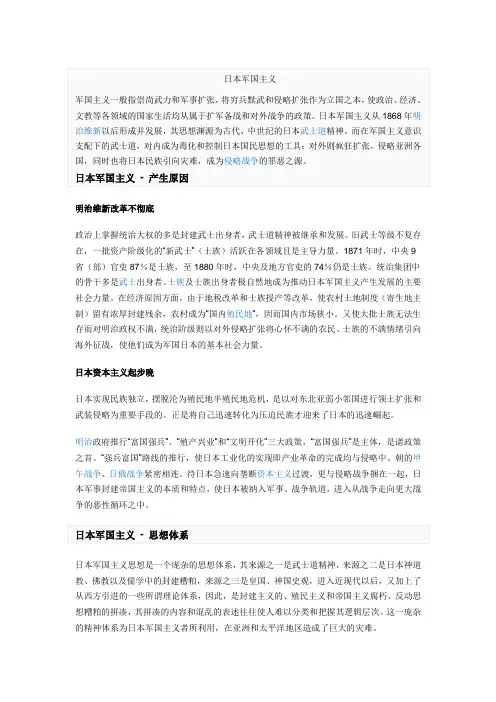
明治维新改革不彻底政治上掌握统治大权的多是封建武士出身者,武士道精神被继承和发展。
旧武士等级不复存在,一批资产阶级化的“新武士”(士族)活跃在各领域且是主导力量。
1871年时,中央9省(部)官吏87%是士族,至1880年时,中央及地方官吏的74%仍是士族。
统治集团中的骨干多是武士出身者。
士族及士族出身者极自然地成为推动日本军国主义产生发展的主要社会力量。
在经济原因方面,由于地税改革和士族授产等改革,使农村土地制度(寄生地主制)留有浓厚封建残余,农村成为“国内殖民地”,因而国内市场狭小。
又使大批士族无法生存而对明治政权不满,统治阶级则以对外侵略扩张将心怀不满的农民、士族的不满情绪引向海外征战,使他们成为军国日本的基本社会力量。
日本资本主义起步晚日本实现民族独立,摆脱沦为殖民地半殖民地危机,是以对东北亚弱小邻国进行领土扩张和武装侵略为重要手段的。
正是将自己迅速转化为压迫民族才迎来了日本的迅速崛起。
明治政府推行“富国强兵”、“殖产兴业”和“文明开化”三大政策,“富国强兵”是主体,是诸政策之首。
“强兵富国”路线的推行,使日本工业化的实现即产业革命的完成均与侵略中、朝的甲午战争、日俄战争紧密相连。
待日本急速向垄断资本主义过渡,更与侵略战争捆在一起,日本军事封建帝国主义的本质和特点,使日本被纳入军事、战争轨道,进入从战争走向更大战争的恶性循环之中。
日本军国主义思想是一个庞杂的思想体系,其来源之一是武士道精神,来源之二是日本神道教、佛教以及儒学中的封建糟粕,来源之三是皇国、神国史观,进入近现代以后,又加上了从西方引进的一些所谓理论体系,因此,是封建主义的、殖民主义和帝国主义腐朽、反动思想糟粕的拼凑,其拼凑的内容和混乱的表述往往使人难以分类和把握其逻辑层次。
这一庞杂的精神体系为日本军国主义者所利用,在亚洲和太平洋地区造成了巨大的灾难。
1、武士道是日本军国主义思想的精神渊源武士道既是日本武士的人生观和世界观,又是武士应尽的义务和职责,包括效忠君主、崇尚武艺和绝对服从等封建道德规范及行为准则。
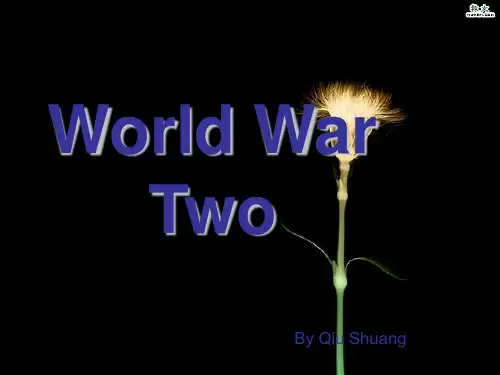

日本,是我国的古老邻邦。
两国自西晋以来的友好交往一直是两国关系的主题。
然而,到了近代,日本与中国却变成了侵略国与被侵略国。
这就不得不提日本近代走上的军国主义道路。
说到日本军国主义及其对中国的侵略危害,就不得不提到日本的明治维新。
日本明治维新,是日本近代史上一次非常奇特的社会变革。
这次变革,既给日本带来了全面开放学习西方的社会效果,同时也给日本带来了天皇军政教合一的政治制度,甚至直接促进了日本对外进行军事扩张。
如果说此前日本的军国主义只是一种趋向或者停留在理论上,那在明治维新之后日本便彻底实践了它。
因此,研究日本明治维新,可以让我们更多了解到所谓的“日本军国主义”。
要讨论日本军国主义的本质不妨从以下两个方面展开:1.从内容上看日本资本主义起步晚,却迅速发展为军事封建帝国主义;这直接归功于明治政府推行的“富国强兵”、“殖产兴业”和“文明开化”三大政策。
“富国强兵”是主体,是诸政策之首。
其中,具有重要意义的是取消旧的军制及建立新的军制。
军制改革的主要内容便是模仿西方,实行征兵制,建立新式的常备军。
它为战争服务的作用不言而喻,这就成为近代日本穷兵黩武的重要基础。
“殖产兴业”是指运用国家政权的力量,以各种政策为杠杆,用国库资金来加速资本原始积累过程,并且以国营军工企业为主导,按照西方的样板,汗大力扶植日本资本主义的成长。
但是由于经济方面改革不彻底,地税改革和士族授产等改革使农村土地制度(寄生地主制)留有浓厚封建残余,农村成为“国内殖民地”,因而国内市场狭小;又使大批士族无法生存而对明治政权不满,统治阶级则以对外侵略扩张将心怀不满的农民、士族的不满情绪引向海外征战,这便又加速了日本的对外侵略,加剧其军国主义程度。
“文明开化”学习西方资本主义国家的教育、文化科学、生活方式等,借以改造日本封建文化,建立资本主义精神文明。
教育上提出“和魂洋才”,以本民族的民族精神为主,鼓吹“忠君”等武士道精神。
这一时期的武士道,对内作为精神工具,毒化和控制日本国民的思想;对外则鼓舞日本国民踏上了侵略亚洲各国的道路。

个人思想政治理论课学生社会实践------大国崛起观后感目录1.开篇----------------------------------------------------------------------------------12.第一集:海洋时代(开篇·葡西)--------------------------------------------4 3第二集:小国大业(荷兰)---------------------------------------------------4 4第三集:走向现代(英国上)------------------------------------------------4 5第四集:走向现代(英国下)------------------------------------------------5 6第五集:激情岁月(法国)---------------------------------------------------5 7第六集:帝国春秋(德国)-----------------------------------------------5—6 8第七集:百年维新(日本)----------------------------------------------------6 9第八集:寻道图强(俄国)----------------------------------------------------6 10第九集:风云新途(苏联)----------------------------------------------6—7 11第十集:新国新梦(美国·上)-----------------------------------------------7 12第十一集:危局新政(美国·下)---------------------------------------7—8 13第十二集:大道行思(结篇)------------------------------------------------8 14 总结交流体会--------------------------------------------------------------8—10开篇《大国崛起》(英文:The Rise of the Great Nations)是2006年在中国中央电视台经济频道(CCTV-2)首播的一部12集电视纪录片,记录了葡萄牙、西班牙、荷兰、英国、法国、德国、俄国、日本、美国九个世界级大国相继崛起的过程,并总结大国崛起的规律。
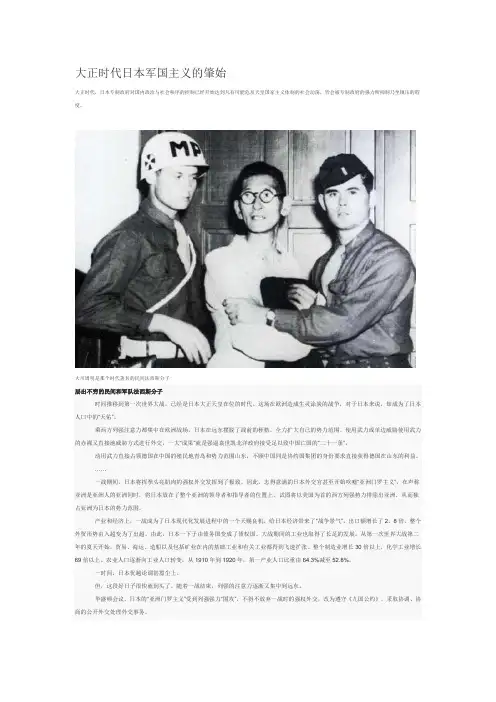
大正时代日本军国主义的肇始大正时代,日本专制政府对国内政治与社会秩序的控制已经开始达到凡有可能危及天皇国家主义体制的社会动荡,皆会被专制政府的强力所抑制乃至镇压的程度。
大川周明是那个时代著名的民间法西斯分子层出不穷的民间和军队法西斯分子时间推移到第一次世界大战,已经是日本大正天皇在位的时代。
这场在欧洲造成生灵涂炭的战争,对于日本来说,却成为了日本人口中的“天佑”。
乘西方列强注意力都集中在欧洲战场,日本在远东摆脱了战前的桎梏,全力扩大自己的势力范围。
使用武力或单边威胁使用武力的赤裸又直接地威胁方式进行外交,一大“成果”就是强逼袁世凯北洋政府接受足以致中国亡国的“二十一条”。
动用武力直接占领德国在中国的殖民地青岛和势力范围山东,不顾中国同是协约国集团的身份要求直接获得德国在山东的利益。
……一战期间,日本将挥拳头亮肌肉的强权外交发挥到了极致。
因此,志得意满的日本外交官甚至开始吹嘘“亚洲门罗主义”,在声称亚洲是亚洲人的亚洲同时,将日本放在了整个亚洲的领导者和指导者的位置上,试图将以美国为首的西方列强势力排除出亚洲,从而独占亚洲为日本的势力范围。
产业和经济上,一战成为了日本现代化发展进程中的一个天赐良机,给日本经济带来了“战争景气”。
出口额增长了2。
8倍,整个外贸形势由入超变为了出超。
由此,日本一下子由债务国变成了债权国。
大战期间的工业也取得了长足的发展。
从第一次世界大战第二年的夏天开始,贸易、海运、造船以及包括矿业在内的基础工业和有关工业都得到飞速扩张。
整个制造业增长30倍以上,化学工业增长69倍以上。
农业人口逐渐向工业人口转变,从1910年到1920年,第一产业人口比重由64.3%减至52.8%。
一时间,日本优越论调甚嚣尘上。
但,这段好日子很快就到头了。
随着一战结束,列强的注意力逐渐又集中到远东。
华盛顿会议,日本的“亚洲门罗主义”受到列强强力“围攻”,不得不放弃一战时的强权外交,改为遵守《九国公约》,采取协调、协商的公开外交处理外交事务。
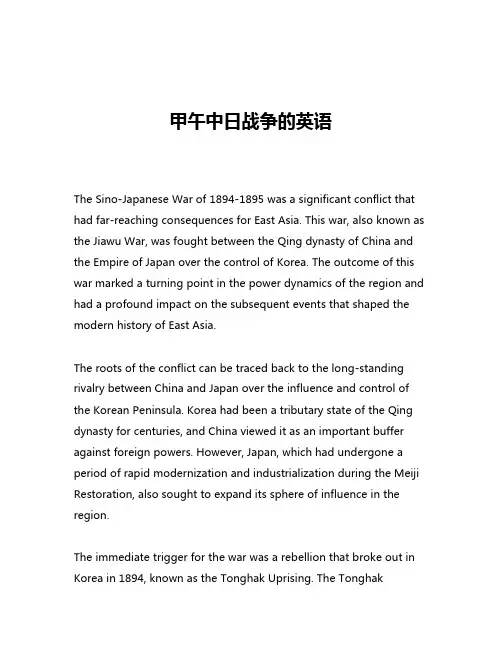
甲午中日战争的英语The Sino-Japanese War of 1894-1895 was a significant conflict that had far-reaching consequences for East Asia. This war, also known as the Jiawu War, was fought between the Qing dynasty of China and the Empire of Japan over the control of Korea. The outcome of this war marked a turning point in the power dynamics of the region and had a profound impact on the subsequent events that shaped the modern history of East Asia.The roots of the conflict can be traced back to the long-standing rivalry between China and Japan over the influence and control of the Korean Peninsula. Korea had been a tributary state of the Qing dynasty for centuries, and China viewed it as an important buffer against foreign powers. However, Japan, which had undergone a period of rapid modernization and industrialization during the Meiji Restoration, also sought to expand its sphere of influence in the region.The immediate trigger for the war was a rebellion that broke out in Korea in 1894, known as the Tonghak Uprising. The Tonghakmovement was a peasant-based religious and political movement that sought to overthrow the corrupt Korean government and its Qing dynasty backers. When the Korean government requested assistance from China to quell the rebellion, Japan seized the opportunity to intervene, sending troops to Korea under the pretext of protecting Japanese citizens living there.The Qing dynasty, aware of the growing threat posed by Japan's expansionist ambitions, also dispatched troops to Korea, leading to a tense standoff between the two sides. Tensions escalated further when Japan launched a surprise attack on the Chinese fleet at the Battle of the Yalu River in September 1894, marking the official outbreak of the war.The Sino-Japanese War that followed was a decisive victory for Japan. The Japanese forces, equipped with modern weapons and trained in Western military tactics, were able to outmaneuver and outgun the Qing dynasty's armies, which were still largely reliant on outdated equipment and strategies. The Japanese also demonstrated superior naval capabilities, with their fleet decisively defeating the Chinese navy at the Battle of the Yalu River.As the war progressed, the Japanese forces quickly gained control of key strategic locations in Korea and Manchuria, including the capture of the Shandong Peninsula and the siege of the Weihaiwei fortress.The Qing dynasty, unable to mount an effective defense, was forced to sue for peace, and the two sides eventually signed the Treaty of Shimonoseki in 1895.The terms of the Treaty of Shimonoseki were highly unfavorable to China. Japan demanded significant territorial concessions, including the cession of the Liaodong Peninsula, the island of Taiwan, and the Penghu archipelago. The Qing dynasty was also required to pay a massive indemnity of 200 million taels of silver to Japan, a sum that was equivalent to nearly two-thirds of the Qing government's annual revenue.The Sino-Japanese War of 1894-1895 had a profound impact on the balance of power in East Asia. The victory of Japan over China demonstrated the former's emergence as a regional military and economic power, while the latter's defeat highlighted the weaknesses of the Qing dynasty and its inability to adapt to the changing geopolitical landscape.The war also had significant implications for the future of Korea. With the Qing dynasty's influence in the peninsula diminished, Japan was able to assert its dominance over Korea, eventually annexing it as a colony in 1910. This marked the beginning of Japan's expansionist policies in the region, which would ultimately lead to the outbreak of the Second Sino-Japanese War and the Pacific Warduring World War II.The Sino-Japanese War of 1894-1895 also had a significant impact on the internal dynamics of the Qing dynasty. The defeat at the hands of Japan was a humiliating blow to the Qing government, and it prompted a series of reforms and modernization efforts known as the Hundred Days' Reform. However, these reforms were short-lived and were ultimately suppressed by the conservative factions within the Qing government.The legacy of the Sino-Japanese War of 1894-1895 continues to resonate in the geopolitics of East Asia to this day. The war's outcome set the stage for Japan's rise as a regional power and the decline of China's influence in the region. It also contributed to the growing tensions between China and Japan, which have remained a source of conflict and political instability in the region.In conclusion, the Sino-Japanese War of 1894-1895 was a pivotal event in the history of East Asia. The Japanese victory over the Qing dynasty marked a significant shift in the regional power dynamics and had far-reaching consequences that continue to shape the political and economic landscape of the region. The war's legacy serves as a reminder of the importance of military modernization, technological advancement, and the ability to adapt to changing geopolitical realities in the pursuit of national interests.。
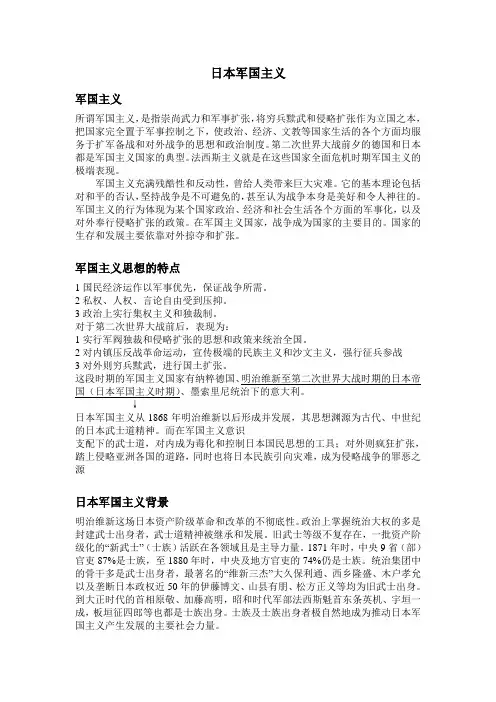
日本军国主义军国主义所谓军国主义,是指崇尚武力和军事扩张,将穷兵黩武和侵略扩张作为立国之本,把国家完全置于军事控制之下,使政治、经济、文教等国家生活的各个方面均服务于扩军备战和对外战争的思想和政治制度。
第二次世界大战前夕的德国和日本都是军国主义国家的典型。
法西斯主义就是在这些国家全面危机时期军国主义的极端表现。
军国主义充满残酷性和反动性,曾给人类带来巨大灾难。
它的基本理论包括对和平的否认,坚持战争是不可避免的,甚至认为战争本身是美好和令人神往的。
军国主义的行为体现为某个国家政治、经济和社会生活各个方面的军事化,以及对外奉行侵略扩张的政策。
在军国主义国家,战争成为国家的主要目的。
国家的生存和发展主要依靠对外掠夺和扩张。
军国主义思想的特点1国民经济运作以军事优先,保证战争所需。
2私权、人权、言论自由受到压抑。
3政治上实行集权主义和独裁制。
对于第二次世界大战前后,表现为:1实行军阀独裁和侵略扩张的思想和政策来统治全国。
2对内镇压反战革命运动,宣传极端的民族主义和沙文主义,强行征兵参战3对外则穷兵黩武,进行国土扩张。
这段时期的军国主义国家有纳粹德国、明治维新至第二次世界大战时期的日本帝国(日本军国主义时期)、墨索里尼统治下的意大利。
↓日本军国主义从1868年明治维新以后形成并发展,其思想渊源为古代、中世纪的日本武士道精神。
而在军国主义意识支配下的武士道,对内成为毒化和控制日本国民思想的工具;对外则疯狂扩张,踏上侵略亚洲各国的道路,同时也将日本民族引向灾难,成为侵略战争的罪恶之源日本军国主义背景明治维新这场日本资产阶级革命和改革的不彻底性。
政治上掌握统治大权的多是封建武士出身者,武士道精神被继承和发展。
旧武士等级不复存在,一批资产阶级化的“新武士”(士族)活跃在各领域且是主导力量。
1871年时,中央9省(部)官吏87%是士族,至1880年时,中央及地方官吏的74%仍是士族。
统治集团中的骨干多是武士出身者,最著名的“维新三杰”大久保利通、西乡隆盛、木户孝允以及垄断日本政权近50年的伊藤博文、山县有朋、松方正义等均为旧武士出身。
关于甲午战争的英语作文全文共6篇示例,供读者参考篇1The Sino-Japanese War - An Epic Battle Between GiantsHi there! My name is Alex, and I'm a 5th grader who really loves learning about history. Today, I want to tell you about this super fascinating war that happened in the 1890s between China and Japan. It was called the Sino-Japanese War, and it was kind of like a clash of the titans back then!So, let me set the scene for you. In the late 1800s, both China and Japan were powerful empires in East Asia. China, which had been a mighty civilization for thousands of years, was kind of like the big kid on the block. But Japan, which had been isolating itself from the rest of the world for a long time, was rapidly modernizing and becoming a major force to be reckoned with.The two nations didn't really get along too well. They had beef over control of Korea, which was kind of stuck in the middle between the two big powers. Korea had traditionally been a vassal state of China, but Japan wanted to increase its influence there too.Things really started heating up in 1894 when a peasant rebellion broke out in Korea. Both China and Japan sent military forces to help the Korean government put down the uprising. But instead of working together, the Chinese and Japanese troops ended up clashing with each other! It was like two bullies fighting over the same turf.And that's how the Sino-Japanese War kicked off in July 1894. The first major battle took place at Pyongyang in Korea, where the Japanese forces surprisingly defeated the Chinese. This was a big deal because everyone had thought China's massive army would easily crush the Japanese.But the Japanese military had been rapidly modernizing with the latest weapons and training techniques from the West. The Chinese forces, on the other hand, were still using rather outdated equipment and tactics. It was kind of like bringing knives to a gunfight!After their victory in Pyongyang, the Japanese forces just kept on rolling. They invaded parts of Manchuria in northeastern China and even landed troops near Beijing, the Chinese capital! The Chinese armies struggled to stop the Japanese onslaught.One of the biggest battles was the naval Battle of the Yalu River in September 1894. It pitted the modern Japanese navyagainst the Chinese Beiyang Fleet. Let's just say it didn't go too well for the Chinese – their fleet was basically demolished by the Japanese warships. It was a huge blow to China's maritime power.Despite their early successes, the war eventually became a grind for Japan as they tried to capture more and more of China's massive territory. The fighting raged on for several more months until China finally threw in the towel in April 1895.In the Treaty of Shimonoseki that ended the war, China had to make a bunch of tough concessions to Japan. They had to cede the Liaodong Peninsula (including Port Arthur) to Japan, recognize Korean independence, pay a huge indemnity, and give Japan lots of trade privileges. Ouch!So in the end, the once powerful Qing Dynasty of China had been humiliated by the rapidly rising Japanese empire. The Sino-Japanese War really shook up the balance of power in East Asia and showed the world how modernized and mighty Japan had become.For China, the defeat was a massive blow both militarily and psychologically. It made them realize how backwards and weak they had become compared to Western nations and newly westernized Japan. This ended up sparking a period of majorreforms in China as they tried to modernize and strengthen the crumbling Qing state.As for Japan, their overwhelming victory over China marked their arrival as a first-rate military power on the global stage. It was the first time in the modern era that an Asian nation had decisively defeated one of the traditional Western-style imperial powers like China. The Sino-Japanese War is considered a pivotal moment in Japanese history.So that's the scoop on the epic Sino-Japanese War of 1894-1895! It was a conflict that sent shockwaves across Asia and showed how the global balance of power was shifting as some ancient empires like China declined while newly modernized nations like Japan rose to prominence.For a couple of massive civilizations that had dominated that part of the world for centuries, this relatively short but hugely impactful war ended up being a major turning point in their respective stories. And it's a chapter of history that still has lots of fascinating lessons to teach us today!篇2The First Sino-Japanese WarHi there! My name is Emily and I'm going to tell you about a really important war that happened a long time ago between China and Japan. It's called the First Sino-Japanese War and it took place in 1894-1895. Before this war, China was a powerful empire that had ruled over East Asia for many centuries. But Japan had become a modern, industrialized nation after the Meiji Restoration in 1868.The war started because both China and Japan wanted to control Korea. Korea used to be a vassal state of China, which meant it had to follow China's orders. But Japan wanted Korea to be free from China so Japan could increase its influence over Korea instead. In 1894, a peasant rebellion broke out in Korea and both China and Japan sent military forces to help the Korean government.The first big battle happened at Pyongyang in Korea on September 15, 1894. The Japanese army defeated the Chinese forces pretty easily because they had better guns, artillery, and training. After this victory, the Japanese were able to take control of Seoul, the capital of Korea. The Chinese had to retreat.Next, the war moved to the seas around Korea and Northeast China. The Japanese navy was much stronger and more modern than the Chinese navy. On September 17, 1894,the Japanese naval forces won a huge victory over the Chinese at the Battle of the Yalu River. Many Chinese ships were sunk or captured.With control of the seas, Japan was able to attack Shandong Province in Northeast China. In November 1894, the Japanese landed troops and captured several cities and ports like Lushunkou (Port Arthur). The Japanese army proved to be better trained, equipped, and led than the Chinese forces.The fighting continued into 1895. Finally, in March 1895 the Chinese were forced to accept defeat and peace negotiations began. The Treaty of Shimonoseki was signed on April 17, 1895. According to the treaty, China had to recognize Korean independence from its influence. China also had to cede the Liaodong Peninsula (including Lushunkou) and the island of Taiwan to Japan. Additionally, China was forced to pay a huge indemnity (payment) of 200 million tael of silver to the Japanese.The First Sino-Japanese War was an embarrassing and costly defeat for China. It showed the outdated state of the Chinese military and government compared to the modernized Japan. The war marked the emergence of Japan as the new dominant power in East Asia, replacing China's historical role. ManyChinese became determined to reform and modernize their country after this humiliating loss.For Japan, the victory showed its status as a modern imperial power that could defeat a historically powerful nation like China. However, the celebrations in Japan were cut short. In 1895, Russia, France and Germany forced Japan to return the Liaodong Peninsula to China because they didn't want Japan gaining too much control in that region. Japan was very angry at having to give back such an important territory after its hard-fought victory.Overall, the First Sino-Japanese War had a huge impact on the balance of power in East Asia. It marked the decline of China's imperial system and the rise of Japan's military and economic strength in the region. The war's outcome inspired nationalists in China to push for modernization, while also stoking tensions between China and Japan that eventually led to more conflicts in the decades ahead.So that's the story of this super important 19th century war between the ancient empire of China and the rapidly modernizing nation of Japan. The Japanese victory shocked the world and kicked off major changes in East Asia that still affect global relations today. Pretty crazy how one war could lead tosuch big consequences, huh? I hope you found my essay interesting and learned something new about this fascinating historical event. Thanks for reading!篇3The First Sino-Japanese War: When China and Japan ClashedHave you ever heard of the First Sino-Japanese War? It was a really big deal back in the 1890s, when China and Japan went to war against each other. Let me tell you all about it!It all started with a fight over Korea. See, Korea was a country that was basically under China's control at the time. But Japan wanted to take over Korea too, because Korea was really close to Japan and the Japanese thought it would be a good idea to make Korea part of their empire.In 1894, there was a rebellion in Korea, and both China and Japan sent soldiers to help out the Korean king. But then the Chinese and Japanese soldiers started fighting each other instead of helping the king! Oops!Japan had been preparing for a war with China for a long time. They had built up their military with the latest weapons andtraining from Europe. China, on the other hand, was still using old-fashioned weapons and tactics from centuries ago.The first big battle happened at sea, near the Yalu River between China and Korea. The Japanese navy completely destroyed the Chinese navy in this battle. China lost almost all of their big ships!After that, the Japanese were able to land their troops in Korea and start pushing the Chinese soldiers back. The Japanese soldiers were much better trained and equipped than the Chinese.The Chinese tried to fight back, but it was really hard for them. In one battle, the Japanese army surrounded a huge Chinese force and captured over 20,000 Chinese soldiers! That's a lot of prisoners.Finally, in early 1895, the Japanese pushed all the way into Manchuria, which was part of China at the time. They got very close to the capital Beijing. China's emperor had no choice but to surrender and make peace.In the peace treaty, China had to give up a lot. They had to recognize Korea as an independent country (although Japanlater took it over anyway). China also had to give the entire island of Taiwan to Japan, as well as the Penghu islands nearby.But that's not all! China also had to pay a huge sum of money to Japan as punishment. It was so much money that China basically went broke and became really weak after the war.The First Sino-Japanese War showed the world how powerful Japan had become with its modern military. It also showed how weak and outdated China's empire had become. Many people say this war marked the beginning of the end for China's last imperial dynasty.For Japan, winning this war made them very confident and hungry for more lands and power. Just a few years later, they picked another fight with a major European country... but that's another story!So in the end, the First Sino-Japanese War was a huge victory for rising Japan and an embarrassing defeat for declining China. It changed the balance of power in Asia and put Japan on the path to building a massive empire. Pretty crazy, huh? Let me know if you have any other questions!篇4The Sino-Japanese War: A Big Fight Between China and JapanA long time ago, in the year 1894, there was a big war between China and Japan called the Sino-Japanese War. It was a really important event that changed history forever. Let me tell you all about it!China and Japan didn't really like each other back then. Japan was becoming a strong country with modern weapons and armies. But China was still very traditional and didn't want to change. There was a lot of tension building up between the two nations.The war started because of a place called Korea. Korea was a small country between China and Japan. Both China and Japan wanted to control Korea because it was very important for trade and power in Asia. There was a peasant rebellion happening in Korea, and both sides sent troops to help the Korean king.The first battle happened on July 25, 1894, near the capital of Korea. Japanese troops attacked the Chinese and Korean forces. It was a huge battle with lots of cannons and guns firing everywhere. The Japanese won this battle easily because their weapons and training were much better than the Chinese.After this first victory, the Japanese forces moved very quickly. They defeated the Chinese army over and over again on land and at sea. The Japanese navy was brand new with big powerful warships. The Chinese navy was very old and could not compete.One of the biggest battles was the naval Battle of the Yalu River on September 17, 1894. Japanese warships sank many Chinese ships and won a massive victory. This showed that Japan's modern navy was far superior.The Japanese army also did very well on land. They invaded parts of China itself and even got close to Beijing, the capital city! Chinese troops fought bravely but they had old guns and swords while the Japanese had new repeating rifles and artillery.By early 1895, it was clear that Japan was winning the war easily. China's armies and navies kept losing battle after battle. Finally, China had to accept defeat and agree to peace.The Treaty of Shimonoseki was signed on April 17, 1895. China had to give up a lot to Japan as punishment for losing the war. Japan got the island of Taiwan and the Penghu islands. They also gained control over Korea, which was what started the war in the first place!China also had to pay over 200 million ounces of silver to Japan as compensation. That's like billions of dollars today! And some ports and cities in China were opened up for Japanese trade and business.This war was a huge embarrassment for China. It showed how weak and out-of-date their military had become compared to rising powers like Japan. Many Chinese people were very angry at their government's failure.For Japan, the victory was amazing. It proved they could beat a much larger nation like China through modern weapons, training, and strategies. Japan was now seen as the biggest power in Asia, replacing old China.The Sino-Japanese War changed the balance of power in East Asia forever. It marked the beginning of Japan's rise as an empire and China's period of suffering through wars, invasions, and rebellion in the coming years.Looking back over a hundred years later, this "big fight" between the two ancient rivals was very important in shaping today's world. Japan became a major force while China had to completely transform to become strong again after such a crushing defeat.Well, that's the story of the Sino-Japanese War in a nutshell! It was a pivotal moment where the ancient empire of China was humbled, and newly modernized Japan burst onto the scene as the emerging power of Asia. Pretty fascinating, right? Let me know if you have any other questions!篇5The Sino-Japanese War: A Big Fight Between China and JapanHave you ever had a really big fight with your brother or sister? Maybe you were fighting over a toy or who got to pick the TV show. Well, imagine if that fight was between two huge countries instead of just you and your sibling! That's kind of what happened with the Sino-Japanese War back in 1894.China and Japan are two countries in Asia that are pretty close neighbors. For a long time, China was way more powerful than Japan. China was this huge, ancient empire that had advanced technology, big cities, and a strong military. Japan, on the other hand, was a smaller set of islands that didn't have as much going on. But in the 1800s, Japan started catching up to China rapidly.You see, Japan realized that European countries like Britain and France had gotten really strong from industrializing - building factories, railroads, steamships, and modern weapons. So Japan said, "Hey, we should do that too!" And they did, quickly modernizing their military and economy. China, meanwhile, wasn't keeping up as well with modern changes.In 1894, a disagreement over control of Korea led to war breaking out between the two nations. At first, I bet Japan's leaders were a little nervous going up against their bigger neighbor China. But Japan's military was far more modern and well-trained compared to China's. Japan had invested a lot in upgrading its navy with armored battleships and cruisers. China's ships were older and out of date.The war kicked off with naval battles. At the Battle of the Yalu River in 1894, Japan's modern fleet blew away China's navy of wooden ships. After that huge victory at sea for Japan, its troops were able to invade parts of China. Japanese soldiers equipped with modern rifles defeated China's armies over and over on land too.Can you imagine how shocking that must have been for China? For so long, they had been the big powerful kid on the block in Asia. But now this upstart neighbor Japan was beatingthem badly with its shiny new toys - I mean, modern warships and guns! It would be like if your pesky little neighbor you always pushed around suddenly became stronger than you out of nowhere.By 1895, China realized they were no match for Japan's military strength. They had to sign a peace treaty giving up stakes in Korea, as well as the island of Taiwan to Japan. Ouch! Losing a major island like that would be like you having to give your room to your badger little brother or sister after they beat you up. No fun!The Sino-Japanese War was a huge wake-up call that revealed how behind the times China had become. They realized they needed to urgently modernize their military and industries, just like Japan had done, if they wanted to be a major world power again. For Japan, their victory proved they had truly arrived as a modern military force to be reckoned with.The war marked the beginning of Japan's rise to later become a major global player in the 20th century. It also showed the growing weakness of China's ancient empire in the face of Western modernization. From that point on, China faced increasing pressure and conflicts with Western nations and anambitious Japan looking to grow its territory and influence in Asia.So in a way, the Sino-Japanese War was a little sibling shoving match between China and Japan that foreshadowed some of the huge events that would later shake up Asia and the entire world in the 1900s. Just like how a little backyard tussle between kids can sometimes turn into a really big deal, this war was just the start of a lot of dramatic future chapters in the story of these two nations and the rest of the globe. Wild, huh?篇6The Terrible War Between China and JapanHave you ever heard about the First Sino-Japanese War? It was a really big deal that happened over 100 years ago, back in 1894 and 1895. Two countries that are pretty close together, China and Japan, ended up going to war against each other. At the time, China was a lot more powerful than Japan, but Japan still managed to win the war. Let me tell you all about it!Back then, China was ruled by the Qing Dynasty. They had been in charge for a really long time, since the 1600s. China was a huge empire that included places like Mongolia, Xinjiang, and even Taiwan. But by the late 1800s, the Qing Dynasty was gettingweaker. Their armies and weapons were pretty outdated compared to Western countries and Japan.Meanwhile, Japan had been working really hard to modernize and build up its military might. They looked at Western nations like Britain and the United States and copied a lot of their technologies and training methods for the armed forces. By 1894, Japan felt confident enough to pick a fight with the declining Qing Dynasty over control of Korea.You see, Korea was historically a sort of vassal state of China, where they had to listen to the Chinese emperor. But Japan wanted to expand its influence in the region too. In 1894, there was a peasant rebellion in Korea, and both China and Japan sent troops there, accusing the other of disrupting the peace.That's when tensions really started to boil over between the two nations. In July 1894, some Japanese and Chinese naval ships got into a fight off the Korean peninsula, and that's considered the official start of the First Sino-Japanese War. It was on!At first, people probably expected China to win easily since it was so much bigger and more populated than Japan. But Japan had put a lot of effort into building up its military with the latest weapons and training based on European styles. China's armyand navy were still using really old-fashioned guns, swords and strategies.The war went terribly for China right from the beginning. In a huge naval battle in September 1894, Japan's modern warships completely destroyed China's outdated fleet. Then the Japanese army invaded first Korea, and then even parts of northeastern China near the Liaodong Peninsula.China's troops were no match for Japan's disciplined,well-equipped forces. By early 1895, Japan had occupied parts of Manchuria and was getting close to the capital of Beijing. Finally, the Qing Dynasty gave up and signed a peace treaty to end the war.In that treaty, China had to give up a lot to Japan. They lost the Liaodong Peninsula and the island of Taiwan to the Japanese Empire. They also had to pay over 200 million taels of silver to Japan, which was an insane amount of money back then. Plus, they had to give up their influence over Korea.The First Sino-Japanese War was a total embarrassment for China's ancient Qing Dynasty. Even though they were much bigger, their outdated military was demolished by Japan's modern, powerful forces in less than a year of fighting. It reallyshowed how behind the times the Chinese were compared to rising powers like Japan.The war made it clear that China desperately needed to reform their government, military and society if they wanted to avoid being bullied by other nations. And for Japan, the overwhelming victory marked their arrival as a major world player that could stand up to the traditional great powers of Europe.Looking back over a century later, the First Sino-Japanese War was a pivotal moment in shifting the global balance of power toward Asia. An ancient empire like China's Qing Dynasty got its butt kicked, while an upstart nation like Japan announced itself as the increasingly dominant force in the region.So that's my take on this hugely important but often overlooked conflict from the 1890s. The images of China'sold-fashioned soldiers and ships getting blown apart by Japan's modern military might is pretty crazy to imagine! I don't know about you, but I'm glad wars like that don't really happen anymore today. Anyway, I hope you found my history report interesting and fun to read!。
大国崛起概括【篇一:大国崛起概括】[编辑本段]剧情简介这是中国中央电视台第一部以世界性大国的强国历史为题材并跨国摄制的大型电视纪录片。
中国正走在中华民族伟大复兴的道路上,中国的富强,将创造人类发展史上的重大事件,这一过程深刻影响着世界格局。
近代以来160多年的追赶,使我们更需要去探索自己的强国之路。
中国的几代领导人反复强调:我们的发展,要吸收和借鉴全人类的文明成果。
那么,在中国的现代化进程中,应该以什么样的胸怀和态度来看待曾经在近现代历史上引领世界潮流的国家?中国的和平发展,可以从中借鉴什么样的经验和教训?2003年11月,中共中央政治局进行了第九次集体学习,学习的内容是:世界上9个主要国家自15世纪以来的兴衰史。
此后,关于这段历史的学习在其他各级党政部门多次进行。
基于这样的背景,中央电视台推出了12集电视系列片《大国崛起》来解读15世纪以来世界性大国崛起的历史,探究其兴盛背后的原因。
15世纪以来,随着地理大发现,世界各国开始相互认识、了解和竞争。
在近现代,有九个国家在不同的历史时期先后登场,对人类社会发展产生了重大影响。
它们是:葡萄牙、西班牙、荷兰、英国、法国、德国、日本、俄罗斯、美国。
《大国崛起》即以上述九国的发展历史为内容。
[编辑本段]分集介绍《大国崛起》全片共12集,每集50分钟,以九国崛起的大致时间为序。
分别为:15世纪,欧洲最早的两个民族国家葡萄牙和西班牙,在国家力量支持下进行航海冒险:在恩里克王子的指挥下,葡萄牙一代代航海家们开辟了从大西洋往南绕过好望角到达印度的航线;在伊莎贝尔女王的资助下,哥伦布代表西班牙抵达了美洲。
当麦哲伦完成人类第一次环球航行后,原先割裂的世界终于由地理大发现连接成一个完整的世界,世界性大国也就此诞生。
葡萄牙和西班牙在相互竞争中瓜分世界,依靠新航线和殖民掠夺建立起势力遍布全球的殖民帝国,并在16世纪上半叶达到鼎盛时期,成为第一代世界大国。
但是,这两个依靠掠夺迅速崛起而没有发展工商业的帝国很快盛极而衰。
近代日本的军国主义与帝国扩张近代日本的军国主义与帝国扩张是20世纪上半叶日本特有的历史现象。
这一时期,日本军国主义思潮盛行,日本政府以扩张为目标,通过军事手段侵略周边国家,追求自身利益的最大化。
本文将探讨近代日本的军国主义和帝国扩张的原因、特点以及其对亚洲地区产生的重大影响。
一、军国主义思潮的形成近代日本军国主义的形成与19世纪末的社会背景息息相关。
维新政权推行的现代化改革使得日本在军事、经济、政治等方面迅速崛起,这增强了日本国内军国主义思潮的滋生土壤。
同时,西方列强的侵略和压迫也对日本国内产生了深远的影响。
日本在19世纪封闭了几百年的锁国政策被打破后,接触到了发达的西方文明以及军事技术。
西方列强对日本的侵略和不平等条约的签订,引起了大量日本国民的愤慨和反思,进而催生了军国主义思潮。
二、军国主义的主要特点1. 推崇军事力量:军国主义倡导军事至上,认为只有强大的军事力量才能保证国家的安全与尊严。
2. 崇拜忠诚与武士道精神:军国主义强调忠诚,追求武士道的精神,崇尚自我牺牲、纪律严明的军事价值观。
3. 塑造国家意识形态:军国主义通过教育、宣传等手段,塑造了一种军国主义的意识形态,使之成为社会共识。
三、帝国扩张的背景与原因日本军国主义追求帝国扩张的动机是多方面的。
首先,日本作为一个资源匮乏的岛国,需要通过扩张来获取资源,确保经济的发展。
其次,军国主义将帝国扩张作为提升国家威望与地位的手段。
通过扩张,日本可以在国际社会中获得更大的话语权,并在亚洲地区树立霸权地位。
最后,军国主义思潮下的日本,追求民族自尊与民族荣誉,将帝国扩张视为民族复兴的象征。
四、日本的帝国扩张行动自19世纪末至第二次世界大战结束,日本展开了一系列的帝国扩张行动。
1904年至1905年的日俄战争使日本吞并了俄罗斯在东北地区的权益,获得满洲地区的控制权。
随后,日本在1910年吞并了朝鲜,并在1931年发动九一八事变侵占中国东北地区。
这些行动奠定了日本在亚洲地区的霸权地位。
罗斯福对日宣战演讲稿中英文版(范文)第一篇:罗斯福对日宣战演讲稿中英文版(范文)罗斯福对日宣战演讲稿英文版PEARL HARBOR SPEECHFranklin Delano RooseveltDecember 8, 1941To the Congress of the United States:Yesterday, Dec.7, 1941the United States of America was suddenly and deliberately attacked by naval and air forces of the Empire of Japan.The United States was at peace with that nation and, at the solicitation of Japan, was still in conversation with the government and its emperor looking toward the maintenance of peace in the Pacific.Indeed, one hour after Japanese air squadrons had commenced bombing in Oahu, the Japanese ambassador to the United States and his colleagues delivered to the Secretary of State a formal reply to a recent American message.While this reply stated that it seemed useless to continue the existing diplomatic negotiations, it contained no threat or hint of war or armed attack.It will be recorded that the distance of Hawaii from Japan makes it obvious that the attack was deliberately planned many days or even weeks ago.During the intervening time, the Japanese government has deliberately sought to deceive the United States by false statements and expressions of hope for continued peace.The attack yesterday on the Hawaiian islands has caused severe damage to American naval and military forces.Very many American lives have been lost.In addition, American ships have been reported torpedoed on the high seas between San Francisco and Honolulu.Yesterday, the Japanese government also launched an attack againstst night, Japanese forces attacked Hong st night, Japanese forces attacked st night, Japanese forces attacked the Philippine st night, the Japanese attacked Wake Island.This morning, the Japanese attacked Midway Island.Japan has, therefore, undertaken a surprise offensive extending throughout the Pacific area.The facts of yesterday speak for themselves.The people of the United States have already formed their opinions and well understand the implications to the very life and safety of our nation.As commander in chief of the Army and Navy, I have directed that all measures be taken for our defense.Always will we remember the character of the onslaught against us.No matter how long it may take us to overcome this premeditated invasion, the American people in their righteous might will win through to absolute victory.I believe I interpret the will of the Congress and of the people when I assert that we will not only defend ourselves to the uttermost, but will make very certain that this form of treachery shall never endanger us again.Hostilities exist.There is no blinking at the fact that that our people, our territory and our interests are in grave danger.With confidence in our armed forceswe will gain the inevitable triumph-so help us God.I ask that the Congress declare that since the unprovoked and dastardly attack by Japan on Sunday, Dec.7, a state of war has existed between the United States and the Japanese empire.罗斯福对日宣战演讲稿中文版副总统先生、议长先生、参众两院各位议员:昨天,1941年12月7日——必须永远记住这个耻辱的日子——美利坚合众国受到了日本帝国海空军突然的蓄意的进攻。
亚洲的战争日本扩张与太平洋战场亚洲的战争: 日本扩张与太平洋战场亚洲历史上发生的战争无疑给这片大陆带来了深远的影响。
其中,日本在二战期间的扩张行动以及太平洋战场上的战争,对整个亚洲乃至全球的历史格局产生了巨大的影响。
本文将就亚洲的战争、日本的扩张行为以及太平洋战场进行探讨,以了解这段历史对亚洲大陆所带来的深远影响。
1. 日本的扩张行为在二战期间,日本实施了一系列的扩张行动,试图成为亚洲的霸主。
日本开始于1931年的“九一八事变”,之后沿着东北亚地区进行侵略,先后入侵了中国东北地区、华北以及中南部分地区。
1937年,日本发动全面侵华战争,对中国发动了大规模的军事进攻。
这些行为不仅对中华民族造成巨大伤害,也对整个亚洲以及全球的战局产生了重大影响。
2. 日本军国主义的崛起在二战之前,日本一直持续推行着军国主义的政策。
这一政策的核心思想是通过军事实力和殖民地控制来实现国家的利益和扩张。
日本的扩张行为不仅是军国主义政策思想的延伸,也是该思想深入人心的结果。
日本军国主义的崛起不仅在当时亚洲战场上带来了巨大冲击,也对整个世界的稳定和和平产生了极大的威胁。
3. 日本在太平洋战场上的作战太平洋战场是二战期间亚洲战争的一部分,这场战争是日本与盟军(以美国为主)之间的对抗。
日本在此战场上策划了一系列的军事行动,试图扩大其在亚洲的势力范围。
然而,日本最终没有能够实现其扩张目标,反而在1945年底经历了广岛和长崎的原子弹轰炸,随后投降。
太平洋战场的结束标志着日本的战争扩张行为告一段落,并为亚洲带来了新的战后局势。
4. 对亚洲的深远影响日本的战争扩张以及太平洋战场所带来的影响是深远的。
首先,日本的侵略行为造成了亚洲国家数以百万计的伤亡,给这些国家造成了不可估量的破坏。
其次,日本军国主义的暴行激起了亚洲各国人民的民族自豪感和抗日情绪。
这种民族主义情绪推动了许多亚洲国家的独立运动和反殖民主义斗争。
最后,战争结束后的太平洋战场成为了冷战的一个关键区域,影响了亚洲局势的演变和全球格局的形成。